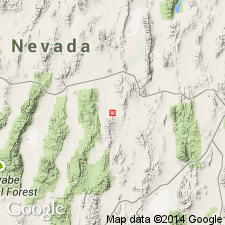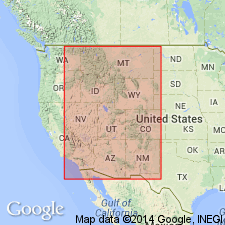
- Usage in publication:
-
- Davis Spring Formation*
- Modifications:
-
- Named
- Dominant lithology:
-
- Siltstone
- Chert
- AAPG geologic province:
-
- Great Basin province
Summary:
Named as formation for Upper Davis Spring, about 3 km southeast of measured section. Type section measured in SE1/4 sec 20, T16N, R51E, northern Antelope Range, Eureka Co., NV in the Great Basin province. Areal extent shown on geologic map (fig. 2). Is very fine grained pale-brown siliceous dolomitic siltstone and finely laminated chert. Thickness at type is 125 m. Unconformably overlies Fenstermaker Wash Formation; conformably underlies Kinkead Spring Limestone. Age considered to be late Kinderhookian to Osagean (Early Mississippian) based on conodonts. Radiolarians present. Reworked Famennian age (Late Devonian) conodonts present. Environment of deposition interpreted to be marine, below wave base, with euxinic bottom waters and oxygenated upper levels.
Source: GNU records (USGS DDS-6; Denver GNULEX).

- Usage in publication:
-
- Davis Spring Formation*
- Modifications:
-
- Age modified
- Biostratigraphic dating
- AAPG geologic province:
-
- Great Basin province
Summary:
Ammonoid PERICYCLUS (GONIOCYCLUS) ANTELOPENSIS n. sp. identified from type section indicates a late Kinderhookian age for the Davis Spring in the Great Basin province. Combined conodont and ammonoid evidence shows PERICYCLUS-bearing beds in Antelope Range belong in SIPHONODELLA ISOSTICHA-Upper S. CRENULATA Conodont Zone.
Source: GNU records (USGS DDS-6; Denver GNULEX).
For more information, please contact Nancy Stamm, Geologic Names Committee Secretary.
Asterisk (*) indicates published by U.S. Geological Survey authors.
"No current usage" (†) implies that a name has been abandoned or has fallen into disuse. Former usage and, if known, replacement name given in parentheses ( ).
Slash (/) indicates name conflicts with nomenclatural guidelines (CSN, 1933; ACSN, 1961, 1970; NACSN, 1983, 2005, 2021). May be explained within brackets ([ ]).

